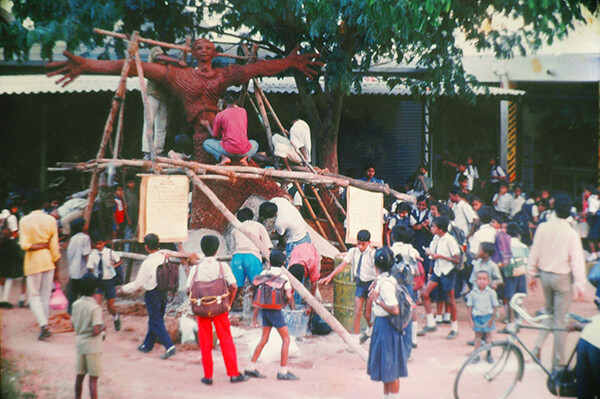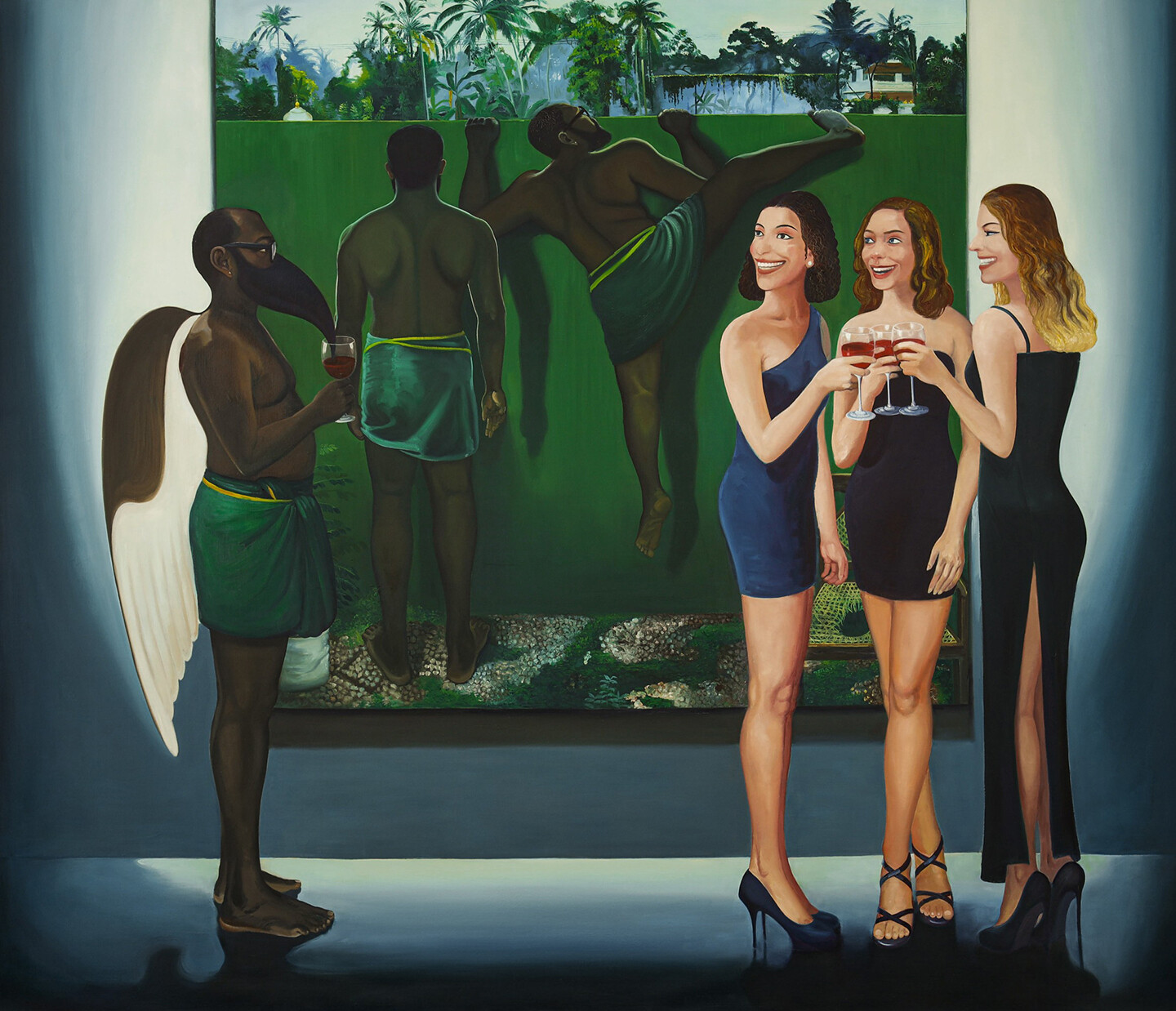South Indian artist Ratheesh T’s practice of looking centers objects, spaces, and people, including his family in his hometown of Kilimanoor, a small town in Trivandrum, Kerala. Here we begin to peel away the layers of a “generative objective knowledge” of a place that forms the core of his work. Many of his paintings show family members and depict land, neighborhoods, and stories that have unfolded within a forty-mile radius of Kilimanoor. In effect, his paintings reveal the lives of his people and the place of his birth. However, Man and Doll (careless objects 2), a 2023 painting, turns Ratheesh T’s gaze inward. The painting shows a stuffed Mickey Mouse doll laid on what appears to be a leather couch, leaning to one side as if alert and at rest at the same time. As much as we stare at this Mickey, it stares back at us, with a consciousness of its own. Surrounding the doll is a green fabric strewn on the surface of the couch, and across from it lies a pair of Jockey boxer shorts. According to the artist, the painting functions as a kind of still life in which he observes a “careless object.” In his parlance, the careless object is something which, though mundane, can provide both the artist and the viewer with various possibilities. It is this “careless object” that offers some kind of beauty. The painting is included in his 2023 solo exhibition at Galerie Mirchandani + Steinruecke in Bombay.
Trained at the Trivandrum College of Fine Arts, Ratheesh T’s focus on forms of looking is reminiscent of philosopher Sundar Sarukkai’s question: “Can experience really be materialised, commodified and transferred without taking the subject of experience into account?”1 The artist’s “careless objects” cannot be divorced from “the subject of experience.” Thus, in addition to a view of art that extends to the social fabric of his community—which is consistent with the spirit of his mentors in the leftist Indian Radical Painters’ and Sculptors’ Association (1986–89)—what might at first glance appear “mundane” in Ratheesh T’s work can actually point towards deeper embodied knowledge, if not fundamental experience. This becomes clear in this oral history account by Ratheesh T, which is a revised and edited version of an interview conducted by curator Srinivas Aditya Mopidevi.
—Serubiri Moses
***
Dance Before Painting
I begin this oral history with dance. I performed Indian classical dance in my childhood, and between ages seven and thirteen I actively performed on stage. But very quickly I was confronted with this white, pale skin all around me. Right now, Indian classical dance is mostly performed by white-skinned people (often upper caste). Black-skinned people (often Dalits and other lower castes) also study Indian classical dance, but today they are made to perform with white makeup. This is a distinctly caste-based politics that plays out in the centuries-old movement practice. I now know the purpose of this, but in childhood I didn’t understand much about the nature of caste, and where the makeup came from. On stage, I wore light-colored makeup, but I still didn’t understand its context in the politics of performance. Then, as I got older, I found out that I had no interest in makeup. Yet when I danced without makeup, I couldn’t win over the audience. As a result, I stopped pursuing classical dance, and became interested in Western dance, which, in my opinion, is much better to perform.
I also started to breakdance and got involved in cinematic dance, also known as film dance, which is associated with Bollywood. Then I found that it is good to perform all over the city. As a result, I became aware of and began studying Michael Jackson’s style of dance. His dancing was impressive. A lot of people in Kilimanoor were familiar with Michael Jackson during the late eighties and early nineties. After a few years of working within the cinematic dance and breakdance circuit, I took classes in hip-hop. I excelled and became a professional dancer in Trivandrum city.
I had not yet attempted painting. At the time, which is when I matriculated into the Trivandrum College of Fine Arts, my drawings were like those of a craftsman. I must be honest and say I only chose to attend the College of Fine Arts in order to explore the city. I wasn’t there to study painting or anything like that. That wasn’t my way. I thought that if I came to the city, I could explore breakdance much more than I had before. That’s how I arrived at the College of Fine Arts, and how my career as an artist began.
It was during my time at Trivandrum College that I came across members of the Radical Group, which was an association of artists at Maharaja Sayajirao University of Baroda between 1986 and 1989 who were influenced by leftist ideas.2 During my earlier studies there were no prominent artists to speak of. I only got to know about these people when I entered Trivandrum College. Jyothi Basu and Alex Mathew and these people were always coming to Trivandrum College, and we spoke about many things.3 I spent a lot of time with them, and learned a lot about the Radical Group. Nowadays, the group is considered canonical. But personally, I could sit down with them. I had a very good relationship with them. That is very important.
Real Experience in Kilimanoor and Varkala
While I studied at Trivandrum College, I got an overseas scholarship and traveled to London. While abroad I managed to visit the Tate Modern and the Barbican Gallery. I gained a deeper understanding of the pulse of contemporary art internationally. When I returned to Trivandrum College, there were a lot of students studying printmaking. They could only understand the technical form of print. We were thinking only about the (formal aspects of the) artwork. That was the main problem I was facing as a student. Unfortunately, today the same thing is happening all over India, such as at the Maharaja Sayajirao University of Baroda. Today, learning is technically possible everywhere, from the library to the internet. But real experience is very different. After returning from London to Trivandrum, I went to Baroda (that is another matter), but I have always remained familiar with my people in Kerala. I have always remained much more familiar with my local community.


The making of Born Free, a sculpture created by John Devraj with three thousand school children, 1994. Indian Radical Painters and Sculptors Association.
Kilimanoor and its forty-kilometer radius have provided the entire source material for my artwork. I have a studio in Trivandrum city, and I have another studio in Kilimanoor, and yet another one at my residence in Varkala (both places are near the city). My family is in Varkala. When traveling to Kilimanoor, I know many people there—given that it is my hometown—and I know a lot about the place. I observe the exterior. I then go back to my residence in Varkala and observe my family, including my kids. They appear in a number of my paintings. But then I return to my studio in Trivandrum, where I observe myself. Painting has become a process of moving between these places and looking at them from different vantage points. I have painted a lot of landscapes and made figurative paintings by observing Kilimanoor and that area. But where does the family painting come from? It is made by observing Varkala and that area.
A Messy Table and Careless Objects
Recently, I was in my studio looking at an object. I recently made two paintings there titled careless objects. When I entered the studio, it was messy. Everything was carelessly placed on the table, like underwear and everything. And once I beheld those things, there was some kind of beauty as I looked more closely. Even if someone else could not envision it, I saw beauty while looking at this messy table. I try to paint things. Put another way, there is a skill that I use very freely in this process of looking more closely at things while in my studio. I witness many more possibilities within these two careless objects paintings. For other works, like black objects, I collected things from the local community in Kilimanoor and Varkala. People were using these dark objects, which I took to the studio. I observed and studied them like a still life. With some other works, such a process wasn’t possible: I couldn’t relocate the objects and therefore was forced to work on the spot. But I have felt the most possibility open up with the careless objects, and I am now able to develop a new painting style. That’s very important for me.
Sundar Sarukkai, “Dalit Experience and Theory,” Economic and Political Weekly 42, no. 40 (October 6–12, 2007): 4043.
On the Radical Group, aka the Indian Radical Painters’ and Sculptors’ Association, see Shankar Tripathi, “Revolutionaries of Indian Art: Revisiting the Kerala Radicals Today,” DeCenter Mag →.
